- Overview
- Account Settings
- Assets
- Connectors Framework
- Overview
- QuickBooks Online
- QuickBooks Desktop Web Connector
- Azure AD
- Salesforce Integration
- FleetNet Connector
- Avalara Connector
- Inbound REST API
- Outbound REST API
- Mailchimp Connector
- Text Messaging Connector
- Clearent Connector
- Stripe Connector
- HubSpot Connector
- UKG Connector
- Paylocity Connector
- UKG Connector
- Gusto Connector
- iSolved Payroll Connector
- Customer Portal
- Customers
- Dashboards
- Devices
- Dispatching
- Forms
- Inventory
- Invoices & Billing
- Locations
- Payments
- Parts
- Projects
- Quotes
- Recurrent Routes
- Recurrent Services
- Reports
- Sales Orders
- Schedule
- Services
- Tasks
- Text Messaging
- Time Tracking
- Users
- Work Orders
On the Settings page you will be able to add or edit quote categories, fields, and even create your own action items to generate invoices quickly and effortlessly, work orders, sales orders, etc. from the quote.
This section will expound on how to utilize the features found on the Settings page, so you will be able to create quote classifications, fields, etc. that can be implemented on your future quotes.
To set up the sales tax, discounts, or markups for the quote, you will first need to set them up in the Invoices Settings page. For more information about this page, please see the Invoices Settings page.
There are two different ways you can access the Settings page:
You can directly access the Settings page, by hovering over the Quote feature from your MobiWork menu, and clicking on the "Settings" option:
While you are on the Quotes feature page, you can also click on the More Actions button located at the top-right of your MobiWork web interface, and from the drop-down select the "Settings" option:
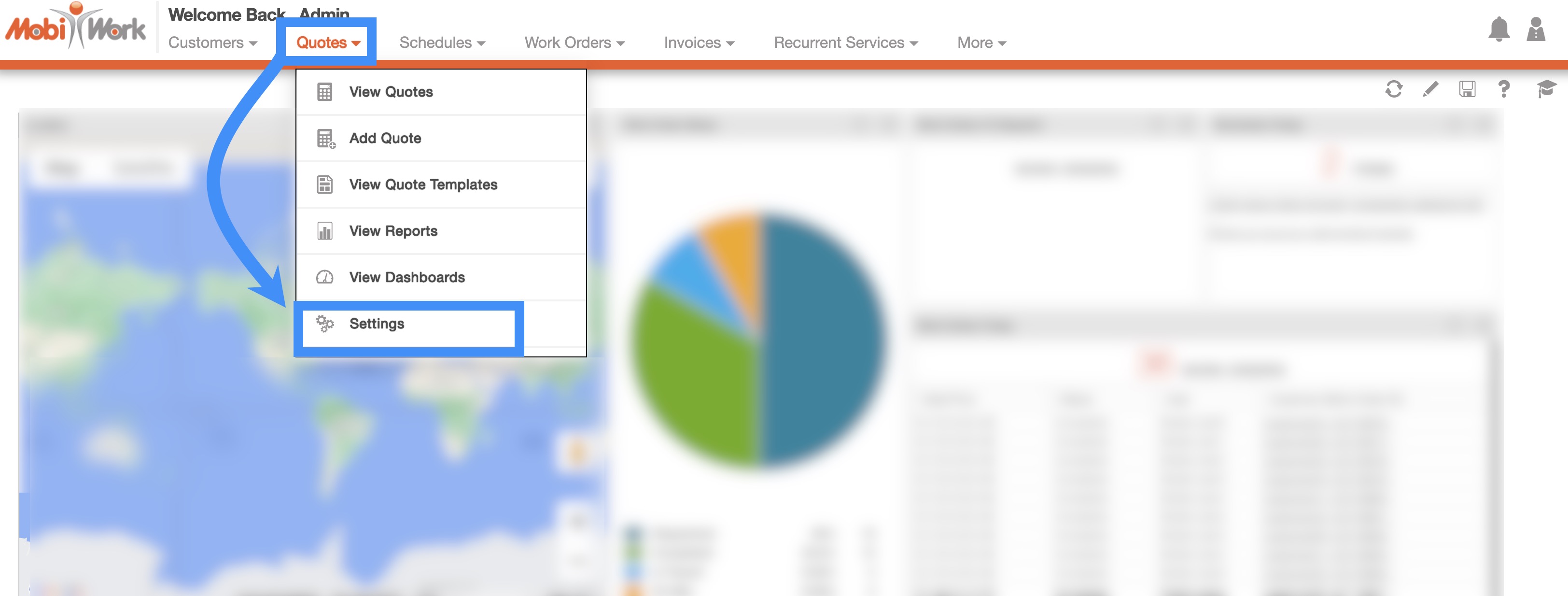

Once you are on the Settings page, there will be several different sections that you can access to further customize your quotes:
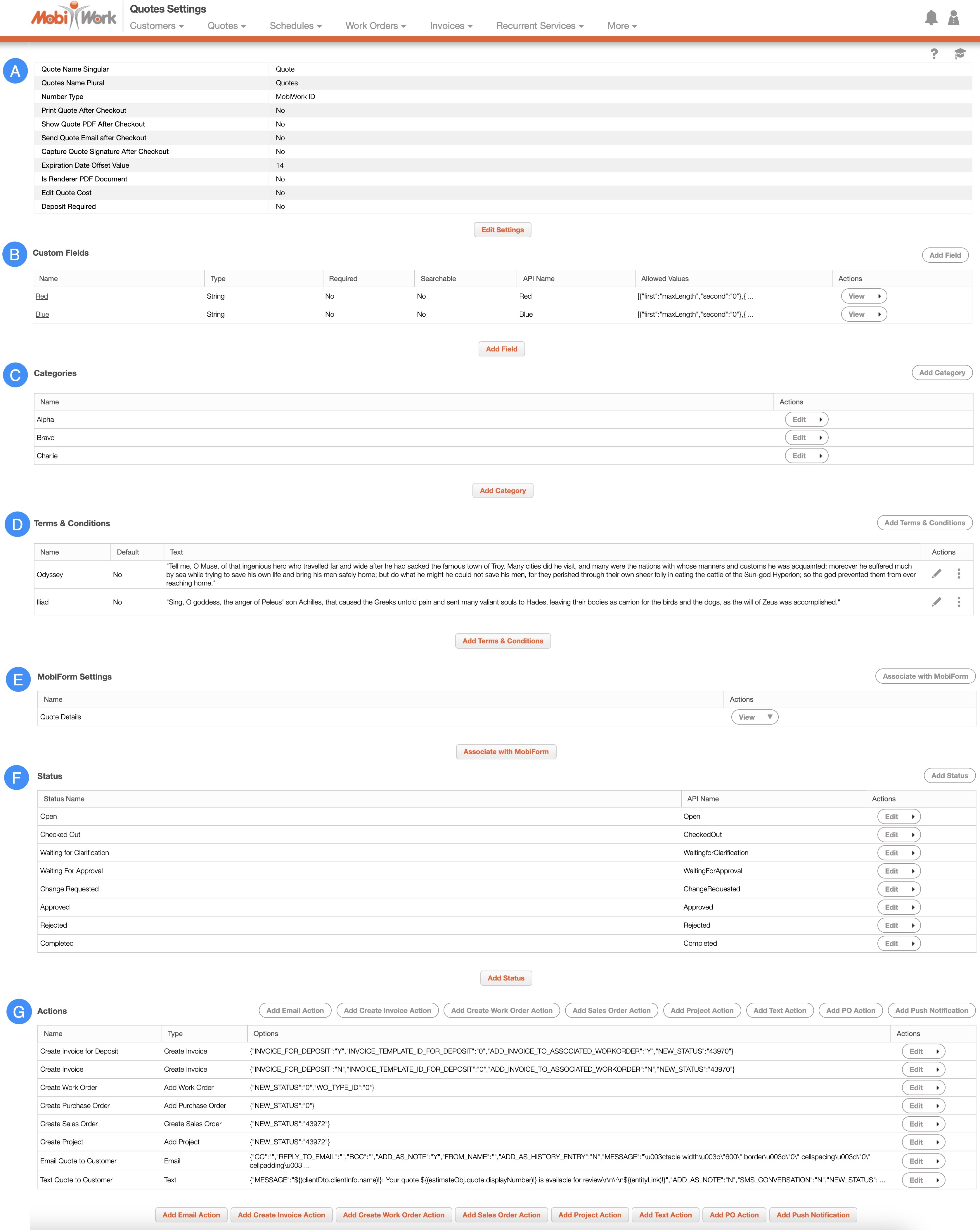
In the "View Settings" section of the Settings page, you will be able to update various aspects of your quotes including, if deposits are required by default, the term that you refer to your quotes, if you want your quote to print after checkout, etc.:

To edit these settings, click on the Edit Settings button. You will then be automatically redirected to the Edit Settings page:
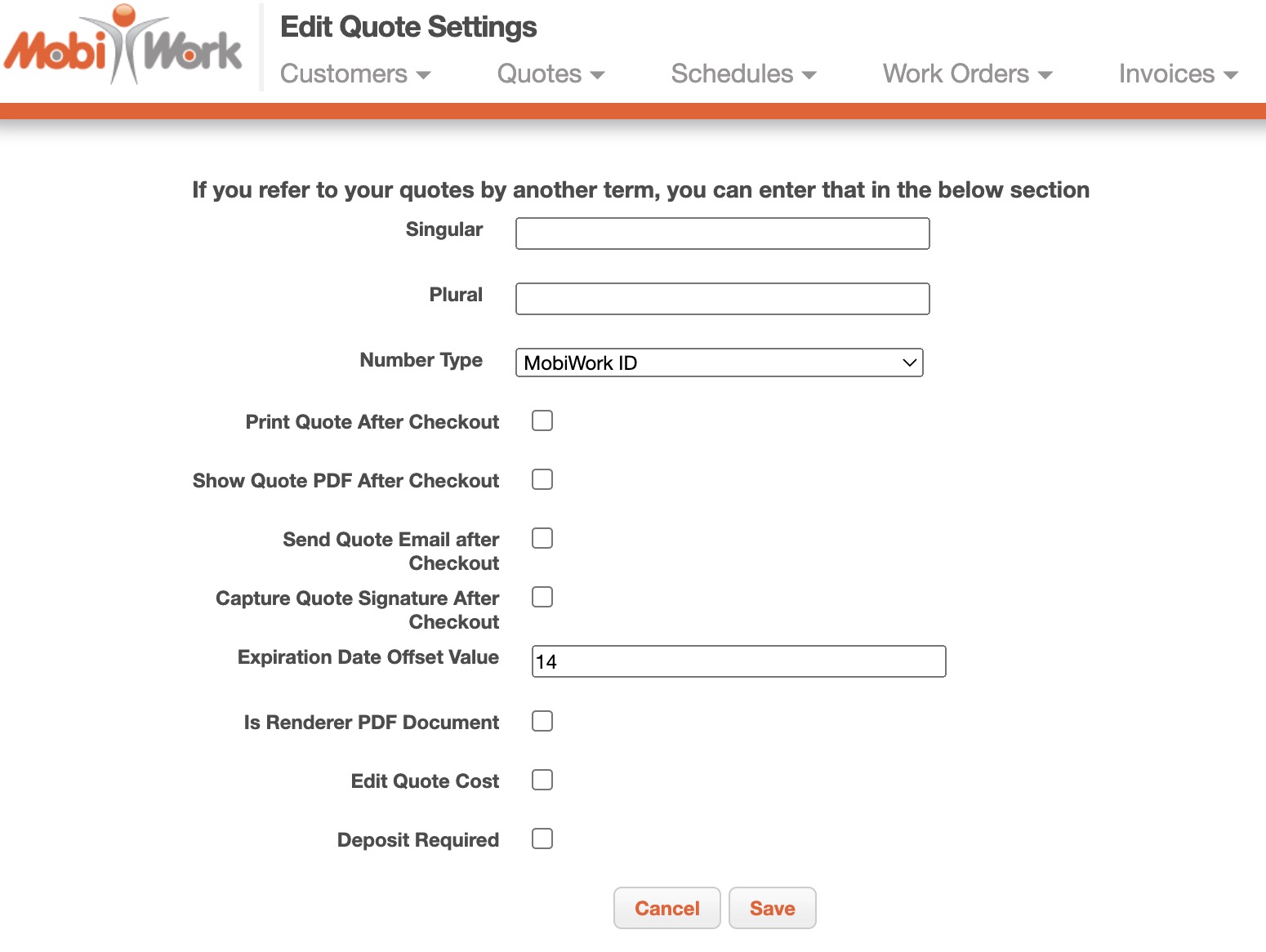
On this page you can:
The term used to indicate how you refer to your quotes (e.g., singular: estimate, plural: estimates).
Indicate what number system you would like to use to manage your quotes (MobiWork ID is selected by default).
Check off if you would like the quote to print after checkout by default.
Check off if you would like to have the quote PDF to display by default after checkout.
Check off if you would like to have the quote to automatically send as an email to the customer after checkout.
Check off if you would like to capture the customer's signature on the quote after checkout.
The default number of days the expiration date should appear after the quote has been generated.
Check off if you would like the quote to be viewable on a PDF renderer document.
Check off if you would like to give your users the ability to edit the quote cost.
Check off if you would like to make a deposit required on your quotes by default.
Once you are satisfied with your changes, click on the Save button to implement your updates.
With the "Custom Fields" section, you can add additional fields to your quotes along with the already existing fields. When you are on the add, edit, view, import/export pages these new fields will appear.
You decide how you want the fields to be displayed. If you want them to be searchable, optional, required, visible by the customer, appear once, etc. you can. It's all up to you!
To add the custom fields, click on the Add Field button and then input the desired information for your new field:

The terms for the "Custom Fields" columns are defined below:
| Name: | Description: |
|---|---|
| "Name" | The name of the custom field. |
| "Type" | The type of custom field. |
| "Required" | If checked, the custom field needs to be completed. |
| "Searchable" | If checked, the custom field will become searchable within the New Search pop-up window. (It will not be searchable in the Free Text Search bar). |
| "API Name" | The API name of the custom field. After the custom field is created this name cannot be changed or altered |
| "Allowed Values" | Shows the configuration information; only provides value during troubleshooting |
| "Actions" | Allows you to view, edit, or delete the custom field |
When you click the Add Field button, you will be automatically directed to another page to add the new quote custom field. Input the desired data range, name, etc. into the fields provided and then click Add to save the new quote custom field.
Below is an example of how the quotes custom field would apply to MobiWork quotes:
This example uses a string property type, that is required, searchable, and customer visible:
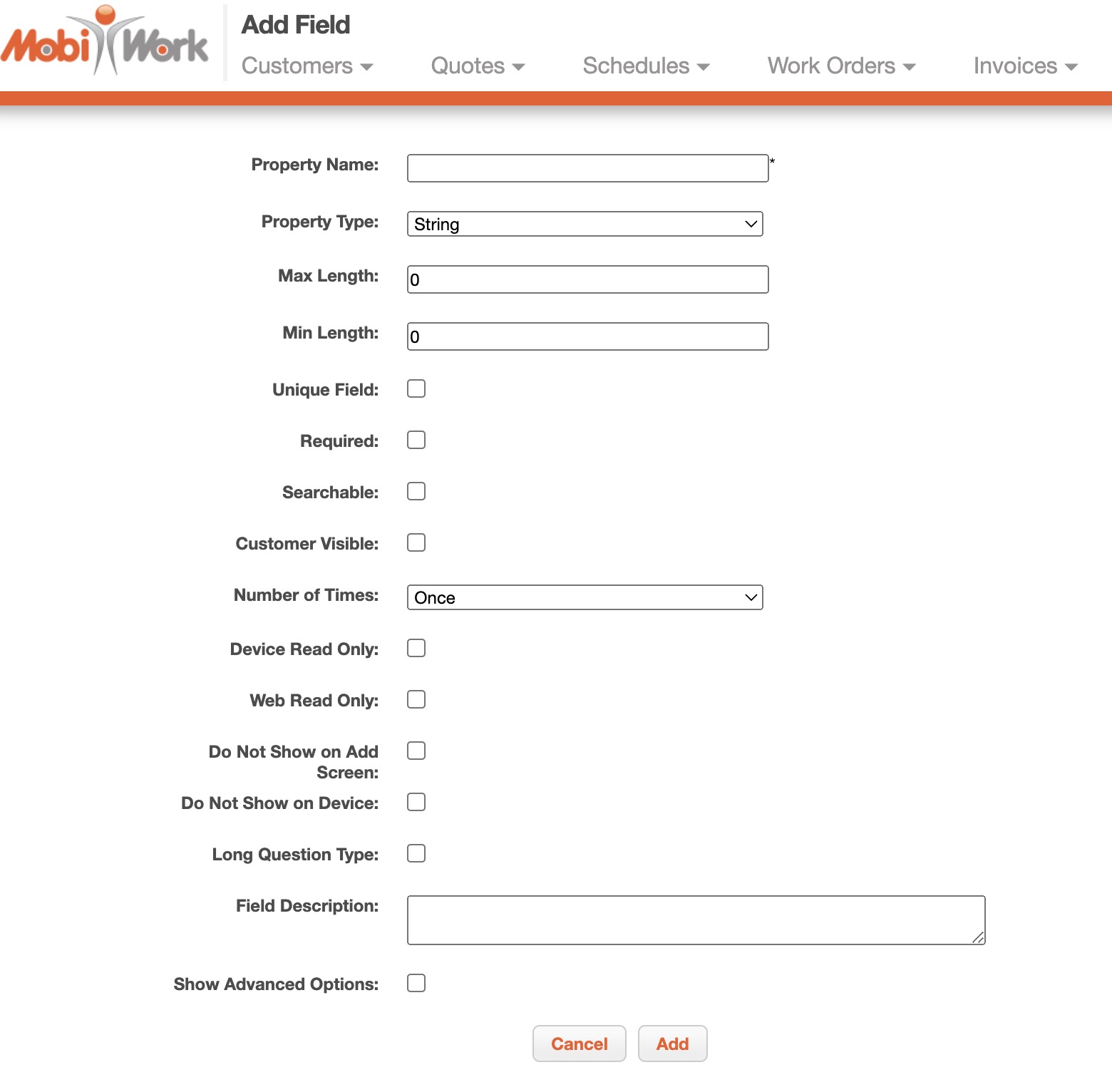
The terms for the adding a custom field are defined below:
| Name: | Description: |
|---|---|
| "Property Name" | The name of the custom field. |
| "Property Type" | is the type of custom field, including the following: |
| ------------------------------------------------------- | --------------------------------------------------------------------------------------------------------------------- |
| "String" | a field where the user can enter text; The field supporting limiting the number of characters that can be entered. |
| "Number" | a number field that does not accept decimals; The maximum and minimum number for the field can be defined. |
| "Decimal" | a number field that does accept decimals; The maximum and minimum number for the field can be defined. |
| "Date" | a field that allows the selection of the date from a pop-up calendar of a 3-field layout; It can be specified whether the current date will automatically appear and cannot be edited. |
| "Yes/No" | a yes/no field indicated by a checkbox. |
| "Multiple Choice" | a multiple option field where the values within it can be specified within "Select Values" by placing a comma between each value; You have the ability to indicate if the first value is invalid (i.e: you can give instructions as the first value, such as Select One:). |
| "QR Code" | a field that captures barcode/QR code data (for the device only). |
| "Signature" | a field to capture signatures (for the device only). |
| "Header" | a bold label that does not allow input. |
| "Image Capture" | an image capturing field that allows photos to be taken or existing images uploaded from the mobile device gallery into the field; It can be specified to not allow images from the device gallery. |
| "Notes" | adds notes to the notes list for the entity; For example, if a form is filled for a work order, then the Note Field content will be added to the work order notes list. |
| "Phone Number" | a phone number field that can be indicated if the phone number will appear in one or three fields. |
| "Phone Number + Extension" | a phone number field that allows an extension to be added; It can be indicated if the phone number plus extension will appear in one or four fields. |
| "SSN" | allows the user to input the Social Security Number within 3 fields (###-##-#### format). |
| "Time Field" | Allows you to specify a 12- or 24-hour time format |
| "Text Area" | a larger text field for multiple sentences, notes, etc. |
| "Vertical Separator" | a vertical line separator between fields. |
| "Vertical Spacing" | places spacing between rows between fields. |
| "Multiple QR Code" | allows the scanning and input of multiple QR codes continuously in this field. |
| "Customer Field" | allows the selection of the customers (available in the permissions) to appear in the field. |
| "Product Field" | allows the selection of the Products (available in the permissions) to appear in the field. |
|
|
|
| "User Field" | allows the selection of the users available in the permissions to appear in this field; Default to Device User will display the user who is logged in on the device within the field. |
| "Project Field" | allows the selection of the projects available in the permissions to appear in the field. |
| "Asset Field" | allows the selection of the assets available in the permissions to appear in the field. |
| "Store Field" | allows the selection of the stores available in the permissions to appear in the field. |
| "Dynamic Header" | allows you to show the data from the associated work order or customer (such as work order description, customer's name, etc.). |
| "Multiple Option Dropdown" | is a dropdown where you can select multiple options. |
| "Document Field" | allows you to upload a document in the field, such as PDF, image, video, etc. |
| "External URL" | a string field that hyperlinks to the URL added in the field. |
| ------------------------------------------------------- | --------------------------------------------------------------------------------------------------------------------- |
| "Required" | Indicates if the custom field is required to fill or not. |
| "Searchable" | If checked, the custom field will become searchable within the New Search pop-up window. (It will not be searchable in the Free Text Search bar). |
| "Customer Visible" | will allow customers to view the form field on the Customer Portal. |
| "Number of Times" | include once, which will show the form field one time, or multiple open-ended, which will add the form field multiple times. |
| "Device Read Only" | means the field cannot be edited on the device. |
| "Web Read Only" | means the field cannot be edited on the web. |
| "Long Question Type" | is for the label of the field; It is a user interface setting which gives more space for the label on the device. |
| "Field Description" | are any comments that describe the field. |
| "Show Advanced Options" | includes the following fields outlined below: |
| "QuickBooks Field Name" | only applies to customer forms/custom fields; This refers to the name of the corresponding field in QuickBooks, which is used during the import/sync. |
| "Label CSS" | is a web only feature that allows the entered HTML CSS attributes to be applied to the field label. |
| "Initial Value for this Field" | sets the initial value of this field when the form is added/opened on the device (This needs to be configured by the MobiWork Professional Services Team). |
The "Categories" section will allow you to add a unique category identifier to better organize your quotes (e.g., internal, external, etc.).
You can also use quote categories to narrow your search in the New Search pop-up window.
When you first access this section there will be no categories listed. To add a new category, click on the Add Category button:

By clicking on the Add Category page you will automatically be brought to the Add Category page. From this page, enter the name for your new category and when you are done click on the Add button:
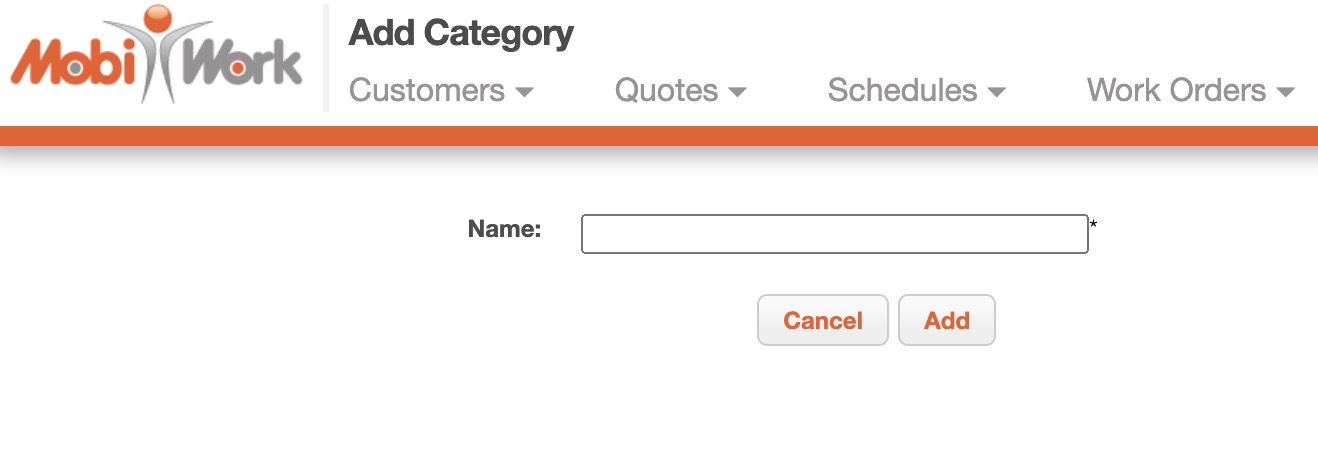
The terms found in the "Categories" section are defined below:
| Name: | Description: |
|---|---|
| "Name" | What the quote category is called. |
| "Actions" | Allows you to edit or delete the selected Quote Category. |
The "Terms and Conditions" section for quotes, will allow you to create a template that will input specified terminology and phrases for the selected quote. You can also use the "Terms & Conditions" field to enter notes regarding the quote or invoice. To add a new terms & conditions template, click on the Add Terms & Conditions button:

Once you click on the Add Terms & Conditions button, the Add Terms & Conditions pop-up window will appear:
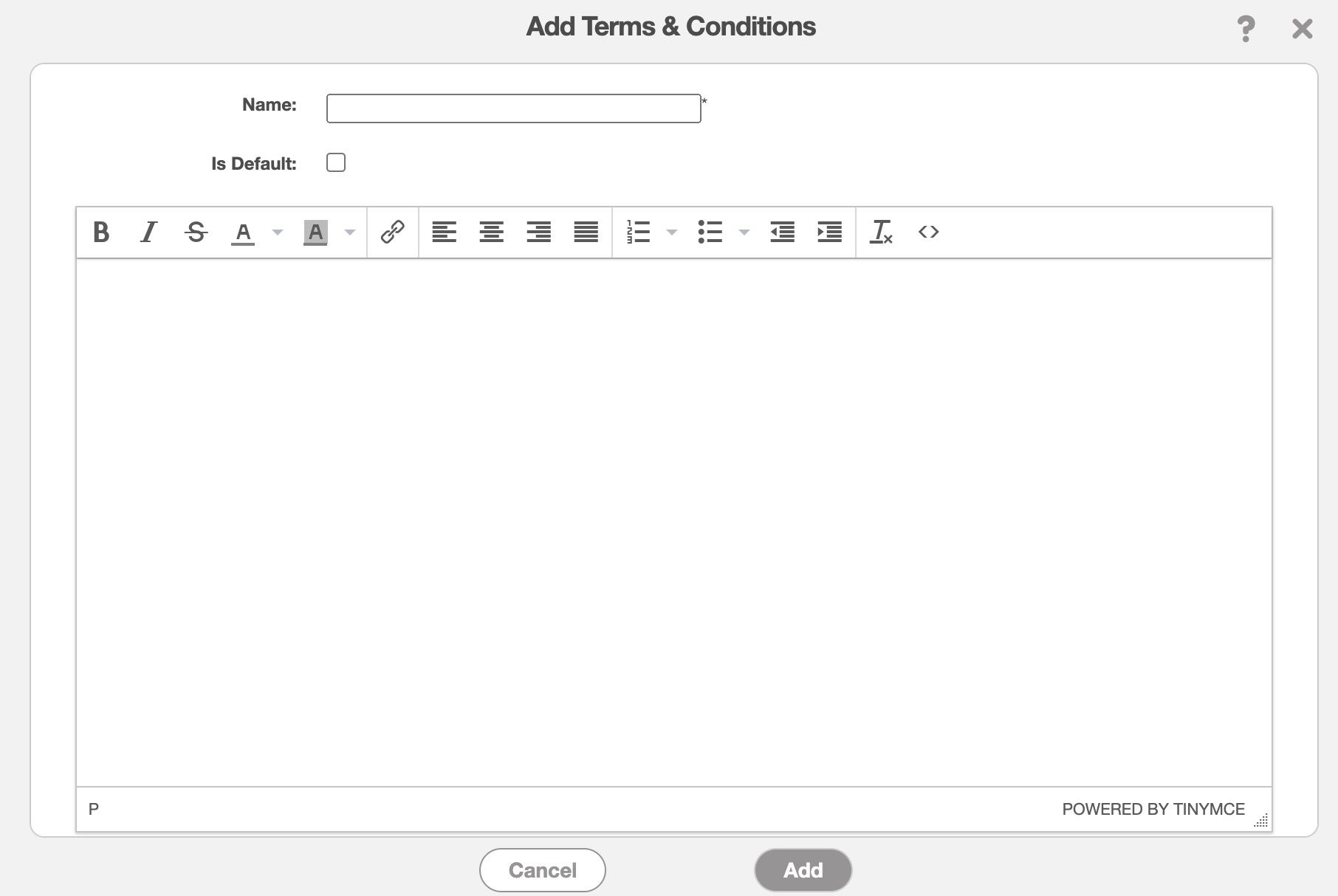
In this pop-up window indicate the following specifications:
The name of the terms and conditions.
If the terms and conditions should be included by default on quotes.
The nomenclature of the terms and conditions.
Once you have finished inputting the desired information, click the Add button to save the terms and conditions.
After you added your terms and conditions on the Settings page, you will be able to access them on the "Summary" tab of the View Quote pop-up window:

To add the terms & conditions, click on the Pencil icon; the Edit Terms & Conditions pop-up window will then appear. From this pop-up window, you can choose the desired terms & conditions from the listed selection.
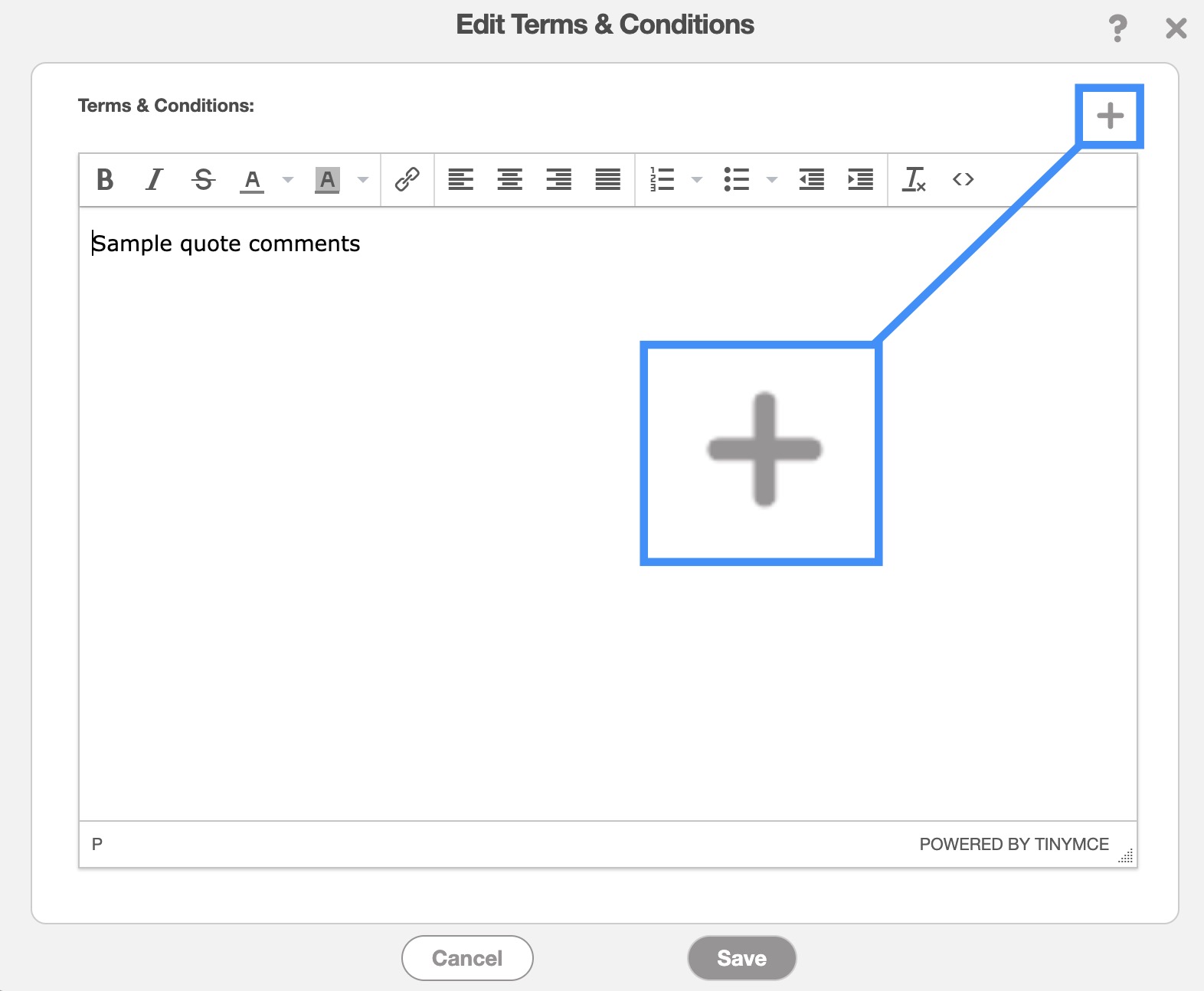
Once you have selected the desired terms and conditions, click the Add button:
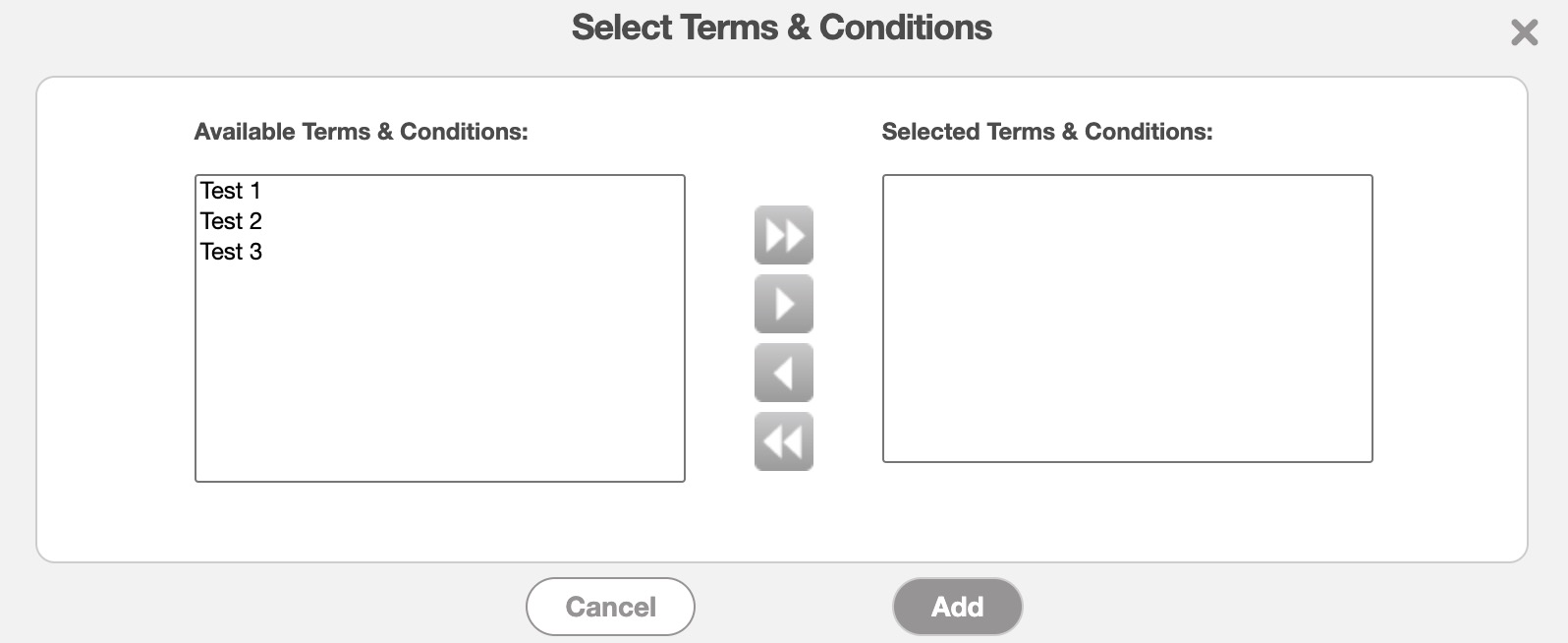
Note: Please note that the Terms & Conditions that are generated in the Quote Settings page will be mirrored for the terms and conditions for invoices.
The terms found in the "Terms & Conditions" section are defined below:
| Name: | Description: |
|---|---|
| "Name" | The name of the Terms & Conditions. |
| "Default" | Indicates if the selected Terms & Condition is to be implemented by default. |
| "Text" | The text that comprises the Terms & Conditions. |
| "Actions" | Allows you to edit or delete the selected Terms & Conditions. |
You can use MobiForms to add fields where quote-associated data can be organized and stored.
Whenever a form is associated with a quote, they will be added to the Forms tab in the View Quote pop-up window.
These forms can be set so you can decide if you would like them to be visible to customers and field workers or not:

When you first access this section in Settings it will be blank; to add Mobiforms click on the Associate with MobiForm button:

Once you click on the Associate with MobiForm button you will be brought to the Add Mobiform page. From this page, use the drop-down to select the name of the Mobiform, the location, where it should display, etc.
The terms found in the "MobiForm" section are defined below:
| Name: | Description: |
|---|---|
| "Name" | The name and type of MobiForm |
| "Form Display Location" | Select how information should be captured. Options include- Do not Capture, which does not fill in customer data now (must get information from the field first), Display Initial (shows all customer information upfront on your field worker's mobile device), and Display in Separate Panel (shows customer information as a tab on your field worker's mobile device). |
| "Display In" | Select where the form should be displayed (either in the Summary tab or Form tab of the View Quote pop-up window) |
| "Show Advanced Options" | Click on Show Advanced Options to access the ability to modify the file layout and code to determine which quote the form is applicable for |
| "Import File Layout" | The file layout for importing forms |
| "Code to Determine Which {0} This Form is for:" | The code that will determine which customer the form is applicable for |
The "Quote Status" section will allow you to add a new status for your quotes or edit existing statuses. These statuses can be set to fit into your business; the default statues are Open, Waiting for Approval, Waiting for Clarification, Approved, and Rejected:

With the ability to create or edit quote statuses you will be able to search for and group certain quotes together; thus, your quote database will be better organized.
For example, if you create two statuses called "Active" and "Inactive," you will be able to easily distinguish between quotes that are active or inactive within your business.
To add a new status, click on the Add Status button. The Add Status page will then appear:

On the Add Status page, type the new status in the text field box and click the Add button when done.
The terms found in the "Customer Status" section are defined below:
| Name: | Description: |
|---|---|
| "Status Name" | What the specified status is called |
| "API Name" | The API name of the status. After the status is created this name cannot be changed or altered |
| "Actions" | Allows you to edit or delete the selected Quote Status |
Actions are a convenient way to perform complex actions on one or more quotes at once (e.g., sending quotes to your customers for approval, creating work orders from the quote, etc.).
These actions will appear in drop-down actions from the "List" tab, the View Quote pop-up window and in the device:

There are various actions can choose from; you can add an email, generate an invoice, generate a work order, add a sales order, add a project action, add a text message action, and a PO action. Depending on your desired outcome, click on the appropriate button.
The columns found in the "Actions" section are defined below:
| Name: | Description: |
|---|---|
| "Name" | The name of the action |
| "Type" | The method in which the action will be performed (e.g., an email action will send out an email, a text message action will send out a text, etc.) |
| "Options" | Shows the configuration information; only provides value during troubleshooting |
| "Actions" | Allows you to edit or delete the action |
Add an Email Action
To add a new email action, click on the Add Email Action button; the Add Action pop-up window will then appear:

Enter the required information and once you are satisfied click on the Add button to save the new action:
Name- What the email action will be called henceforth.
To- Who will be the recipients of the email message.
CC- Who will be carbon-copied on the email message (receives a copy of the email and is visible to other recipients).
Change Entity Status to- Once the email is sent the entity status will change to the status listed in the drop-down.
From Name- The sender of the email message.
Reply To- The recipient of the email message.
Subject- The subject title of the email message.
Message- The message body of the email message.
Allow Action on Multiple Entities- If checked, the email action can be performed on multiple quotes.
Add Entity as a PDF Attachment- If checked, will add the entity information as a PDF attachment.
Allow Documents to be Added- If checked, documents can be added to the email action.
Add a Note to the Entity- If checked, will add a note to the entity.
Send using Gmail- If checked, the email will be sent using Gmail.
Change Entity Status to- Once the email is sent the entity status will change to the status listed in the drop-down.
Add a "Create Invoice" Action
To add a new invoice creation action, click on the Add Create Invoice Action button; the Add Create Invoice Action pop-up window will then appear:

Enter the required information and once you are satisfied click on the Add button to save the new action:
Name- What the invoice creation action will be called henceforth.
Change Entity Status to- Once the invoice is created, the entity status will change to the status listed in the drop-down.
Allow Action on Multiple Entities- If checked, the invoice creation action can be performed on multiple quotes.
Add to Associated Work Order- If checked, the quote will be added to the associated work order automatically.
Add "Create Work Order From Quote" Action
To add a new "Create Work Order From Quote" action click on the Add "Create Work Order From Quote" Action button; the Add "Create Work Order From Quote" Action pop-up window will then appear:

Enter the required information and once you are satisfied click on the Add button to save the new action:
Name- What the work order creation action will be called henceforth.
Work Order Type- The type of work order that is related to the quote.
Change Entity Status to- Once the work order is created, the entity status will change to the status listed in the drop-down.
Allow Action on Multiple Entities- If checked, the work order action can be performed on multiple quotes.
Add Sales Order Action
To add a new sales order action, click on the Add Sales Order Action button; the Add Action pop-up window will then appear:

Enter the required information and once you are satisfied click on the Add button to save the new action:
Name- What the sales order creation action will be called henceforth.
Change Entity Status to- Once the sales order is created, the entity status will change to the status listed in the drop-down.
Allow Action on Multiple Entities- If checked, the sales order action can be performed on multiple quotes.
Add to Associated Work Order- If checked, the quote will be added to the associated work order automatically.
Add Project Action
To add a new project action, action click on the Add Project Action button; the Add Action pop-up window will then appear:

Enter the required information and once you are satisfied click on the Add button to save the new action:
Name- What the project generation action will be called henceforth
Change Entity Status to- Once the project is generated, the entity status will change to the status listed in the drop-down
Allow Action on Multiple Entities- If checked, the project generation action can be performed on multiple quotes
Add a Text Action
To add a new text action, click on the Add Text Action button; the Add Action pop-up window will then appear:

Enter the required information and once you are satisfied click on the Add button to save the new action:
Name- What the text action will be called henceforth
To- Who will be the recipients of the text message
Message- The message body of the text message
Allow Action on Multiple Entities- If checked, the text action can be performed on multiple quotes
Add a Note to the Entity- If checked, will add a note to the entity
Change Entity Status to- Once the text message is sent the entity status will change to the status listed in the drop-down
Add PO Action
To add a new PO action, click on the Add PO Action button; the Add Action pop-up window will then appear:

Enter the required information and once you are satisfied click on the Add button to save the new action:
Name- What the PO action will be called henceforth
Change Entity Status to- Once the PO is generated, the entity status will change to the status listed in the drop-down
Allow Action on Multiple Entities- If checked, the PO action can be performed on multiple quotes
Add Push Notifications
To add a new Push Notification action, click on the Add Push Notification button; the Add Action pop-up window will then appear:

Enter the required information and once you are satisfied click on the Add button to save the new action:
Name- What the push notification will be called henceforth
To- Who will be the recipients of the push notifications
Message- The message body of the push notification
Change Entity Status to- Once the push notification is generated, the entity status will change to the status listed in the drop-down
If you have any questions or need further assistance, please let us know. We'd be happy to help!
